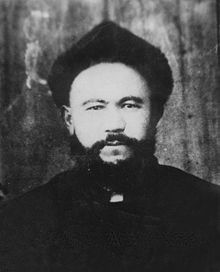Sabit Damolla
Sabit Damolla | |
|---|---|
 Sabit Damolla in his 20s-30s | |
| Prime Minister of the Turkic Islamic Republic of East Turkestan | |
| In office 12 November 1933 – 6 April 1934 | |
| Preceded by | Office established |
| Succeeded by | Office abolished |
| Personal details | |
| Born | June 1883 Atush, Qing dynasty |
| Died | July, 1934 [1] Aksu, Republic of China[2] |
| Political party | |
Sabit Damolla (Uyghur: سابىت داموللا; Chinese: 沙比提大毛拉·阿不都爾巴克; June 1883 – 1934)[4] was a East Turkestan independence movement leader who led the Hotan rebellion against the Xinjiang Province government of Jin Shuren and later the Uyghur leader Khoja Niyaz. He is widely known as the first and only prime minister of the short-lived Turkic Islamic Republic of East Turkestan from November 12, 1933, until the republic's defeat in May 1934.
Life
Sabit Damolla Abdulbaqi was born in 1883, in county of
Kumul Rebellion
Between November 12, 1933, and April 6, 1934, he was selected the prime minister of the short-lived Turkic Islamic Republic of East Turkestan (TIRET) in Kashgar. Sabit Damulla was also behind a creation of Independent Government in Khotan on March 16, 1933, which he proclaimed together with Emir Muhammad Amin Bughra. Later this Government expanded its authority to Kashgar and Aksu through the "Eastern Turkestan Independence Association" and contributed to the proclamation of a republic in the Old City of Kashgar on November 12, 1933. Khoja Niyaz, the leader of Kumul Rebellion in 1931, was invited by Sabit Damulla to Kashgar to assume presidency of the self- proclaimed Republic.

Death
Contemporary sources say that Abdulbaki was captured by Khoja Niyaz near Aksu in late April 1934, then delivered to Governor Sheng Shicai. He was executed reportedly by hanging in July 1934 in
References
- ISBN 0-521-25514-7.
- ISBN 0-521-25514-7.
- ISBN 0-521-25514-7. Retrieved 2010-06-28.
- ISBN 978-90-04-28809-6.
- ISBN 978-0-231-13924-3.
- ^ Tursun, Nabijan (December 2014). "The influence of intellectuals of the first half of the 20th century on Uyghur politics". Uyghur Initiative Papers (11). Central Asia Program: 2. Archived from the original on 2016-10-12.
- ^ Institute of Muslim Minority Affairs (1982). Journal of the Institute of Muslim Minority Affairs, Volumes 4-5. King Abdulaziz University. p. 299. Retrieved 2010-06-28.
- Mark Dickens "The Soviets in Sinkiang (1911-1949)". USA 1990.
- Michael Zrazhevsky "Russian Cossacks in Sinkiang". Almanach "Third Rome", Russia, Moscow, 2001
